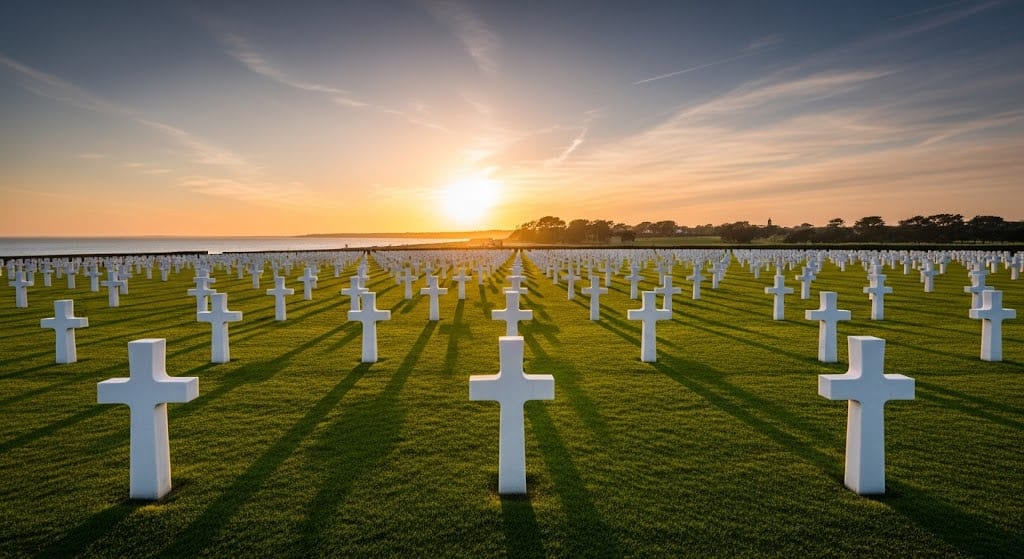From D-Day to Liberation: A Historical Journey Through France

France served as a major theater of World War II, and the historical sites of Nazi occupation and resistance are well-preserved to this day. These meaningful locations offer visitors the opportunity to reflect on courage, sacrifice, and the value of freedom while planning a journey that honors the past.
Normandy Region - The Stage of D-Day Landing Operations
Normandy was the historic site of the Allied landing operations on June 6, 1944, marking the turning point for European liberation. This region remains one of the most significant WWII destinations in France.

Major Sites to Visit
Omaha Beach:
Omaha Beach witnessed the fiercest battles fought by American forces during the landings. The site holds profound significance as the location where Allied forces gained their crucial foothold in Nazi-occupied Europe. Visitors can pay respects to fallen heroes at the Normandy American Cemetery in Colleville-sur-Mer, which serves as the final resting place for nearly 10,000 American soldiers. The beach also features the moving sculpture "Les Braves" at Anilore Banon, which stands as a tribute to the courage of those who landed here.

Utah Beach Museum:
Built at the exact location where Allied forces landed, this museum provides detailed information and artifacts from the D-Day operations. The museum operates daily from 10:00 AM to 6:00 PM, with extended summer hours. Entry fees typically range from €8-12 for adults, with discounts available for students and seniors.

Sainte-Mère-Église Airborne Museum:
This museum is located in the first French town liberated by paratroopers, showcasing the heroic actions of airborne divisions and related exhibits. The town still maintains its historic charm, with the famous church where paratrooper John Steele's parachute famously got caught on the steeple.

Caen Memorial Museum (Mémorial de Caen):
Added a new immersive cinema in 2019 to vividly convey 20th-century European history. The museum operates special exhibitions commemorating the 80th anniversary of the Normandy landings and offers comprehensive coverage of not just D-Day, but the entire context of World War II. Open daily from 9:00 AM to 6:00 PM, with the last entry at 5:30 PM.

Arromanches 360 Circular Cinema:
Features the film "The 100 Days of Normandy" shown on nine large screens, recreating the Battle of Normandy. This unique 19-minute immersive experience provides visitors with a powerful understanding of the battle's progression.

Paris - History of Occupation and Liberation
Paris experienced both the dark period of Nazi occupation and the joyous moment of liberation, housing various WWII-related historical sites that tell these contrasting stories.
Museums and Memorials
Paris Liberation Museum (Musée de la Libération de Paris):
Officially named "Paris Liberation Museum - General Leclerc Museum - Jean Moulin Museum," this museum provides comprehensive exhibits on Nazi occupation and French Resistance activities. Located at 4 Avenue du Colonel Henri Rol-Tanguy (Place Denfert-Rochereau), the museum features an actual preserved Resistance secret command bunker 20 meters underground.

Open Tuesday-Sunday, 10:00 AM-6:00 PM (closed Mondays), with free admission to permanent collections. The museum offers a unique mixed reality experience in the underground shelter, making it the first museum to use VR technology in preserved historical settings. An audio guide is available in multiple languages through a free mobile app.
Shoah Memorial (Mémorial de la Shoah):
Features the "Wall of Names" engraved with the names of 76,000 Holocaust victims and the "Wall of the Righteous" bearing the names of 3,400 people who saved Jewish lives. The memorial also displays photographs of approximately 2,500 Jewish people deported from France.

Located at 17 Rue Geoffroy l'Asnier in the Marais district, the memorial is open daily except Saturdays from 10:00 AM to 6:00 PM (until 9:00 PM on Thursdays). Admission is free, and free guided tours in French are available every Sunday at 3:00 PM, with English tours on the second Sunday of each month.
Les Invalides Military Museum:
Exhibits French military history from the Napoleonic Wars to World War II, operating a Charles de Gaulle exhibition hall. The museum also houses the Museum of the Order of Liberation, dedicated to those who received France's second-highest honor during WWII. Open daily 10:00 AM to 6:00 PM, with admission around €15 for adults.

Historical Sites
Memorial of the Martyrs of Deportation (Mémorial des Martyrs de la Déportation):
Commemorates 200,000 victims sent to Nazi concentration camps. Located on Île de la Cité, the exhibition hall is positioned at the same level as the Seine River, creating a powerful symbolic effect.

Lyon - Center of Resistance Movement
Lyon served as a key city for the French Resistance movement, and its history is well-preserved today through dedicated museums and memorials.
Center for the History of the Resistance and Deportation (Centre d'Histoire de la Résistance et de la Déportation):
Provides comprehensive exhibits on the resistance movement history of Lyon and the Rhône-Alpes region. The museum recreates civilian life under Nazi occupation and resistance activities, maintaining detailed archives on concentration camp deportations.

Special Memorial Sites
Oradour-sur-Glane
On June 10, 1944, Nazi forces massacred 642 residents of this village. Following Charles de Gaulle's decision, the destroyed village was preserved as it was rather than being rebuilt, creating what is known as a "lidless coffin" that testifies to Nazi atrocities.

The site consists of two parts: the preserved martyr village (free to visit) and the Centre de la Mémoire (Memory Center) with detailed exhibitions about the massacre and the rise of Nazism. The Memory Center charges an admission fee of approximately €8-10 for adults.
Opening Hours:
- January 15 - February 28: 9:00 AM - 4:00 PM
- March 1 - May 15: 9:00 AM - 5:00 PM
- May 16 - September 15: 9:00 AM - 6:00 PM
- September 16 - October 31: 9:00 AM - 5:00 PM
- Closed December 16 - January 14
Annual visitation reaches approximately 300,000 people, making it one of France's most important memorial sites.
Armistice Memorial (Compiègne)
The historic site where both World War I and World War II armistice agreements were signed. The museum displays a restored armistice train car and serves as the location where Hitler received France's surrender, making it a site of profound historical significance.

Resistance Movement Sites
Grenoble Museum of the Resistance and Deportation:
Exhibits resistance activities that took place in the mountains and forests of the Isère region, explaining the historical background of Grenoble earning the title "Companion of the Liberation."

Vichy:
Served as the capital of the Vichy government from 1940-1944, representing the historical site of the Nazi collaborationist regime. While controversial, it provides important context for understanding France's complex wartime history.
Travel Tips and Practical Information
Transportation and Accessibility
- Paris to Normandy: Train or tour bus (2-3 hours)
- Most major museums are accessible by public transportation
- Paris Liberation Museum: Metro lines 4, 6, 12, 13 to Montparnasse-Bienvenüe station
Admission Fees and Operating Hours
- Most national memorials offer free or low-cost admission
- Shoah Memorial: Free admission
- Paris Liberation Museum: Free permanent exhibitions
Recommended Itineraries
- Day Tours: Paris to Normandy D-Day beaches (departing 6:30-7:00 AM, returning 7:30-9:00 PM)
- 2-3 Day Course: Intensive Normandy region exploration
- Week-long Course: Comprehensive tour including Paris-Normandy-Lyon
Special Recommendations
- Wear comfortable shoes when visiting Normandy (stairs and beach walking required)
- Guided tours recommended for understanding historical context
- Allow adequate time and mental preparation due to emotionally impactful content
- Best visiting times: Late spring (April-May) and early fall (September-October) for mild weather and fewer crowds
Practical Planning Tips
Best Time to Visit:
- Spring (April-May): Mild temperatures (12-18°C), fewer crowds, perfect for outdoor exploration
- Summer (June-August): Warm weather (20-25°C) but peak tourist season with larger crowds
- Fall (September-October): Ideal temperatures and manageable crowds
- Winter (November-March): Cooler and rainier with shorter hours but significantly fewer tourists
Booking and Reservations:
- D-Day sites: Beaches are accessible 24/7, but museums have specific hours
- Memorial sites: Many require advance booking for guided tours
- Weekday visits typically offer a more personal experience with smaller crowds
Accommodation Recommendations:
- Normandy: Consider staying in Arromanches-les-Bains, Bayeux, or Caen for central access to D-Day sites
- Paris: Any central location with metro access works well for visiting WWII sites
- Special Events: Book well in advance if visiting during memorial anniversaries (June 6, November 11)
Through this journey, visitors can deeply appreciate the preciousness of freedom and peace while keeping the lessons of history alive in memory. France's WWII heritage sites serve not merely as tourist destinations, but as educational venues for learning history and reflecting on the value of peace, carrying profound meaning for current and future generations.
The preservation of these sites demonstrates France's commitment to remembering both the darkest and most heroic chapters of its history, ensuring that the sacrifices made for freedom are never forgotten.
